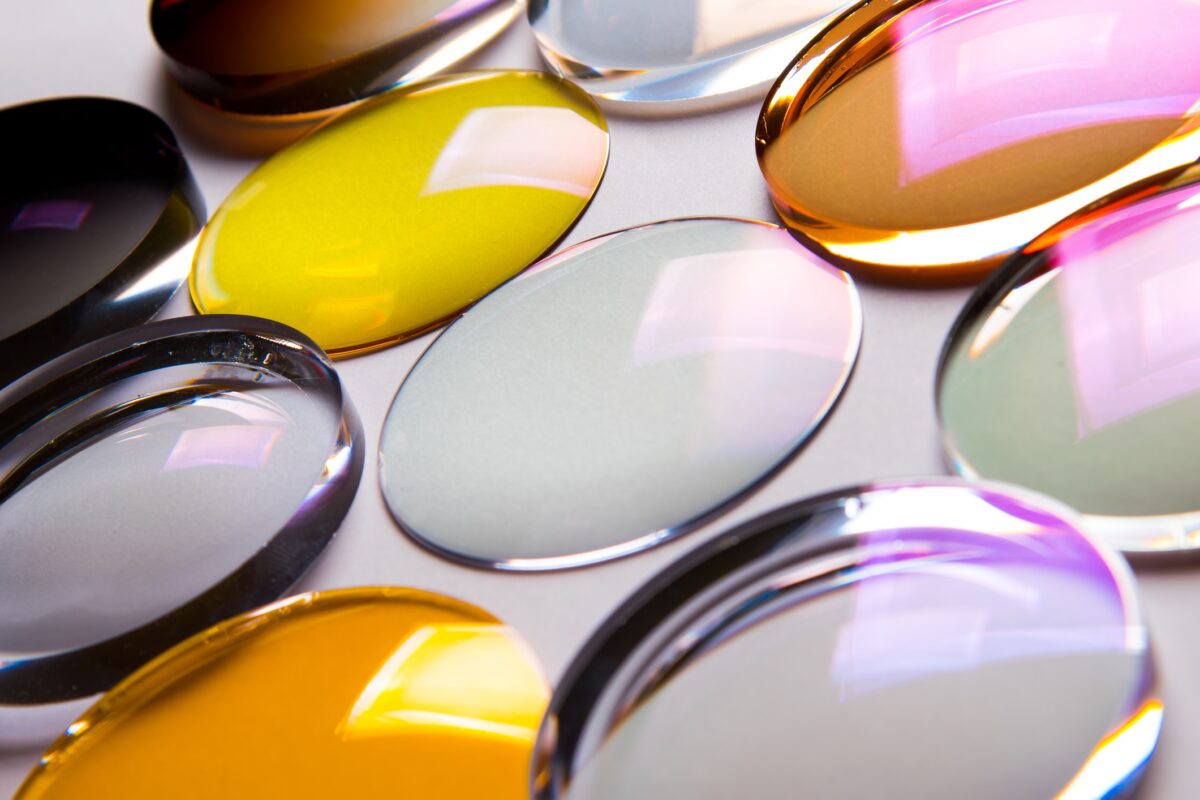Mineral lenses in eyeglass optics – we supply you with the strengths you need.
- Info
- September 2, 2024
- No Comments
Mineral glasses vs. silicate glasses
Mineral glasses, also known as silicate glasses, are still an important part of eyeglass optics and offer a variety of benefits for eyeglass wearers. These glasses are made from natural raw materials and are characterized by their special properties that distinguish them from plastic glasses.
Mineral glasses and silicate glasses are essentially the same thing. Mineral glasses are a special type of silicate glasses that consist mainly of silicon dioxide (SiO₂) and other oxides.
Manufacturing process – how are mineral glasses made?
The production of mineral glasses takes place in several steps. First, the raw materials, mainly silicon dioxide, are melted in a blast furnace together with other oxides such as sodium oxide and calcium oxide. At high temperatures, the mixture is poured into the desired shape and then cooled. After cooling, the glass goes through a tempering process to relieve stress in the material and increase strength. Here are the essential steps of the manufacturing process:
1. Raw material selection
The main components of mineral glasses are silicon dioxide (SiO₂), sodium oxide (Na₂O), calcium oxide (CaO) and sometimes other oxides such as magnesium oxide (MgO) and aluminum oxide (Al₂O₃). These raw materials are carefully selected to ensure the desired properties of the final product.
2. Melting
The selected raw materials are melted in a blast furnace at temperatures of around 1,480 °C. During this process, the mixture is homogenized to achieve a uniform glass structure. The melt has an amorphous structure, which means that it does not have a regular crystal structure.
3. Homogenization
To avoid bubbles and impurities in the glass, the molten mass is homogenized by stirring for several hours. This helps to minimize streaks and inclusions that could affect the optical properties of the glass.
4. Shaping
After melting, the glass mass is formed into the desired shape. This is often done by pressing or pouring into molds specifically designed for the production of ophthalmic lenses. Automatic presses are often used in the production of ophthalmic lenses to ensure precise shaping.
5. Cooling and tempering
After shaping, the glass must be slowly cooled to relieve stress in the material. This process, known as tempering, is crucial to increasing the strength and durability of the glass.
6. Surface treatment
To improve scratch resistance and other properties, mineral glasses can be treated with special coatings. These include anti-reflective coatings that reduce annoying light reflections, as well as special coatings that make the glass more resistant to scratches.
Properties of mineral and silicate lenses
Mineral lenses have high optical clarity and a high refractive index, which means they refract light very well and ensure clear vision. They are particularly scratch-resistant and offer superior resistance to mechanical influences. These properties make them an ideal choice for many eyeglass lenses, especially for people with severe visual defects, as they can be made thinner and lighter without compromising optical quality. Another advantage of mineral lenses is their UV resistance. They offer natural protection against harmful ultraviolet radiation, which protects the wearer’s eyes and reduces the risk of eye diseases.
Here are ten important properties that characterize mineral lenses:
- High optical clarity: Mineral lenses offer excellent light transmission and clear vision, making them ideal for eyeglass lenses.
- Scratch resistance: They are very resistant to scratches, which increases the longevity of the lenses.
- Higher refractive index: Mineral lenses have a higher refractive index than many plastic lenses, meaning they can be made thinner and lighter for the same vision correction.
- UV protection: They provide natural protection from harmful ultraviolet radiation, which protects wearers’ eyes.
- Chemical resistance: Mineral lenses are less susceptible to chemical attack, which increases their durability in different environments.
- Low thermal expansion: They have a low coefficient of thermal expansion, meaning they are less prone to deformation when temperatures change.
- Stability: Mineral lenses are stable and retain their shape over long periods of time, making them a reliable choice for eyeglass wearers.
- Heavier weight: Compared to plastic lenses, mineral lenses are heavier, which can affect comfort, especially with large glasses.
- Risk of injury: If broken, mineral lenses can break into many small pieces, which can be potentially dangerous, unlike plastic lenses, which are generally more shatter-resistant.
- Versatility: Mineral lenses can be manufactured in a variety of shapes and tints, including progressive and sunglass lenses, expanding their application in optics. iBer currently does not offer tinting of mineral lenses.

Use in eyewear
Mineral lenses are used in several different types of eyeglass lenses:
- Single vision lenses: These lenses correct a single visual impairment, such as nearsightedness or farsightedness.
- Progressive lenses: They offer seamless vision correction for people who want to see both near and far. Mineral progressive lenses are particularly popular because they ensure clear vision at all distances.
- Sunglass lenses: Mineral lenses can be given a special tint to protect the wearer from the sun’s rays. These lenses not only provide privacy but also UV protection.
- Special lenses: In certain applications, such as sports glasses or safety glasses, mineral lenses are preferred due to their robustness and scratch resistance. They offer clear vision and are resistant to mechanical influences.
- Optical instruments: Mineral lenses are also used in optical instruments such as microscopes and telescopes where high optical precision is required. Their clarity and stability make them a preferred choice in scientific and technical optics.
Advantages and disadvantages of mineral lenses / silicate lenses
Advantages
- High scratch resistance: Mineral lenses are significantly more scratch resistant than many plastic lenses, making them more durable and maintaining the quality of vision over a longer period of time.
- Optical clarity: They offer excellent optical clarity and high light transmission, resulting in better vision.
- UV protection: Mineral lenses offer natural protection against harmful UV radiation, which protects the eyes of wearers.
- Stability: These lenses are more stable and less prone to deformation, making them suitable for certain professions where the glasses are exposed to extreme conditions.
- Higher refractive index: Mineral lenses can be made thinner and lighter at high diopter values, making them attractive to people with severe visual defects.
Disadvantages
- Weight: Mineral lenses are heavier than plastic lenses, which can affect wearing comfort, especially with large or thick lenses.
- Risk of breakage: In the event of an impact, mineral lenses can break and shatter into many small pieces, posing a risk of injury.
- Sensitivity to impact: They are more prone to breaking when hit or dropped, meaning they are less robust than many modern plastic alternatives.
- Cost: Mineral lenses tend to be more expensive than plastic lenses, which can be a disadvantage for some wearers.
- Less flexible: Compared to plastic lenses, mineral lenses are less flexible in shaping, which can limit design options.
Mineral glasses product range from iBer Berliner Optische Technologie GmbH
Discover the wide selection of mineral glasses at iBer Berlin. Our mineral glasses are characterized by high optical clarity and excellent scratch resistance, which guarantee you clear vision and a long service life.
At iBer Berliner Optische Technologie GmbH, quality and customer satisfaction are our top priority. Contact us and see for yourself the advantages of our mineral glasses. We look forward to your call.






No comment yet, add your voice below!